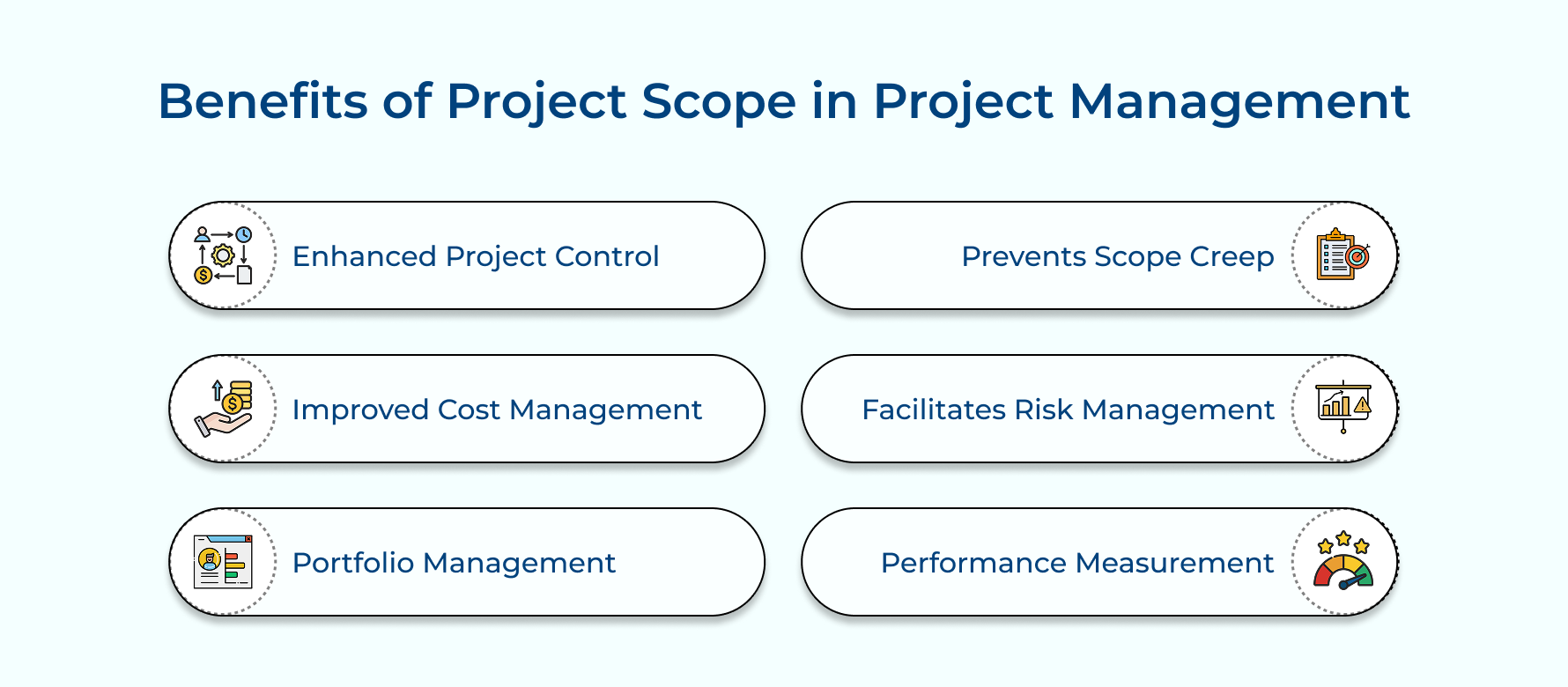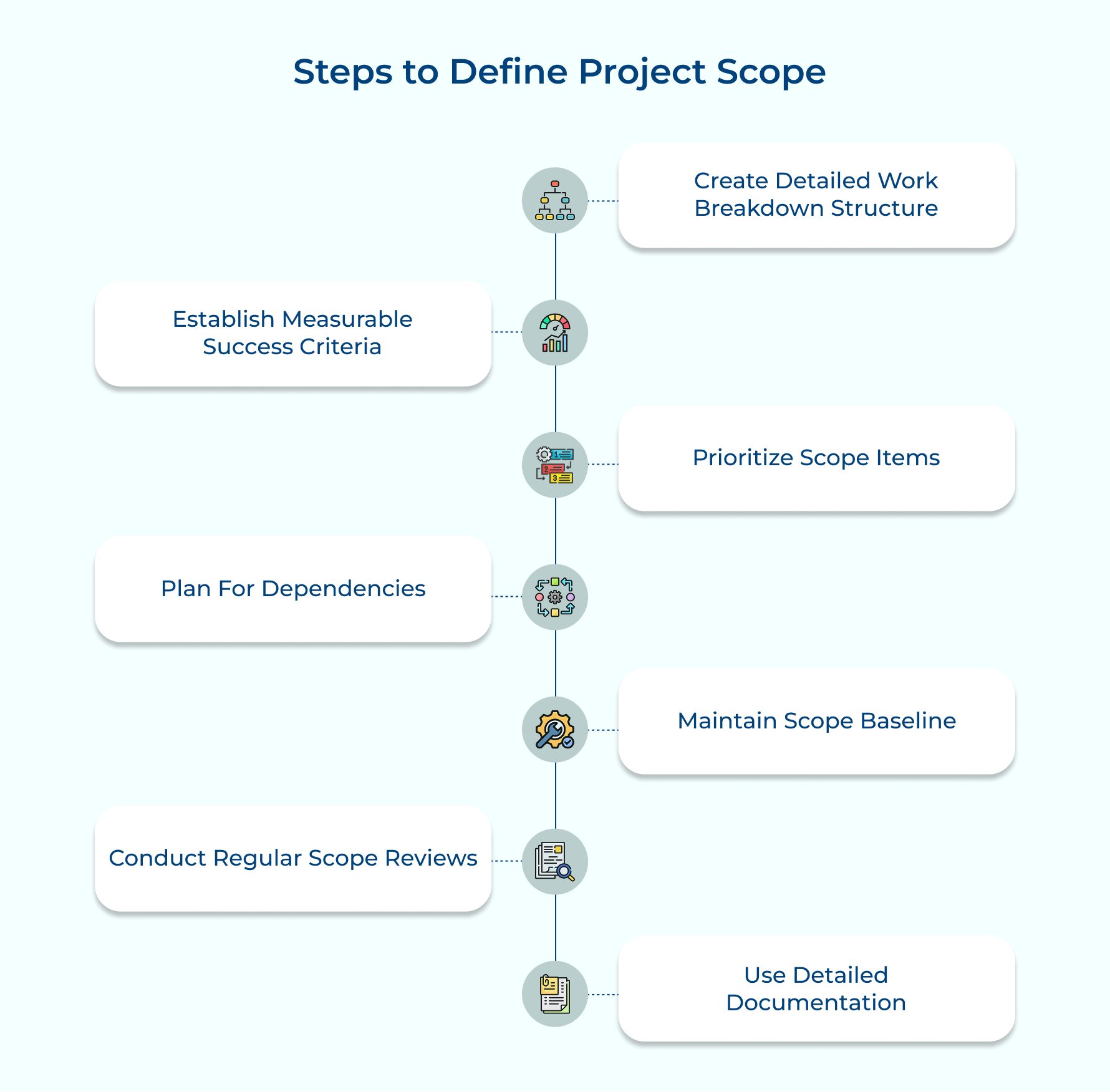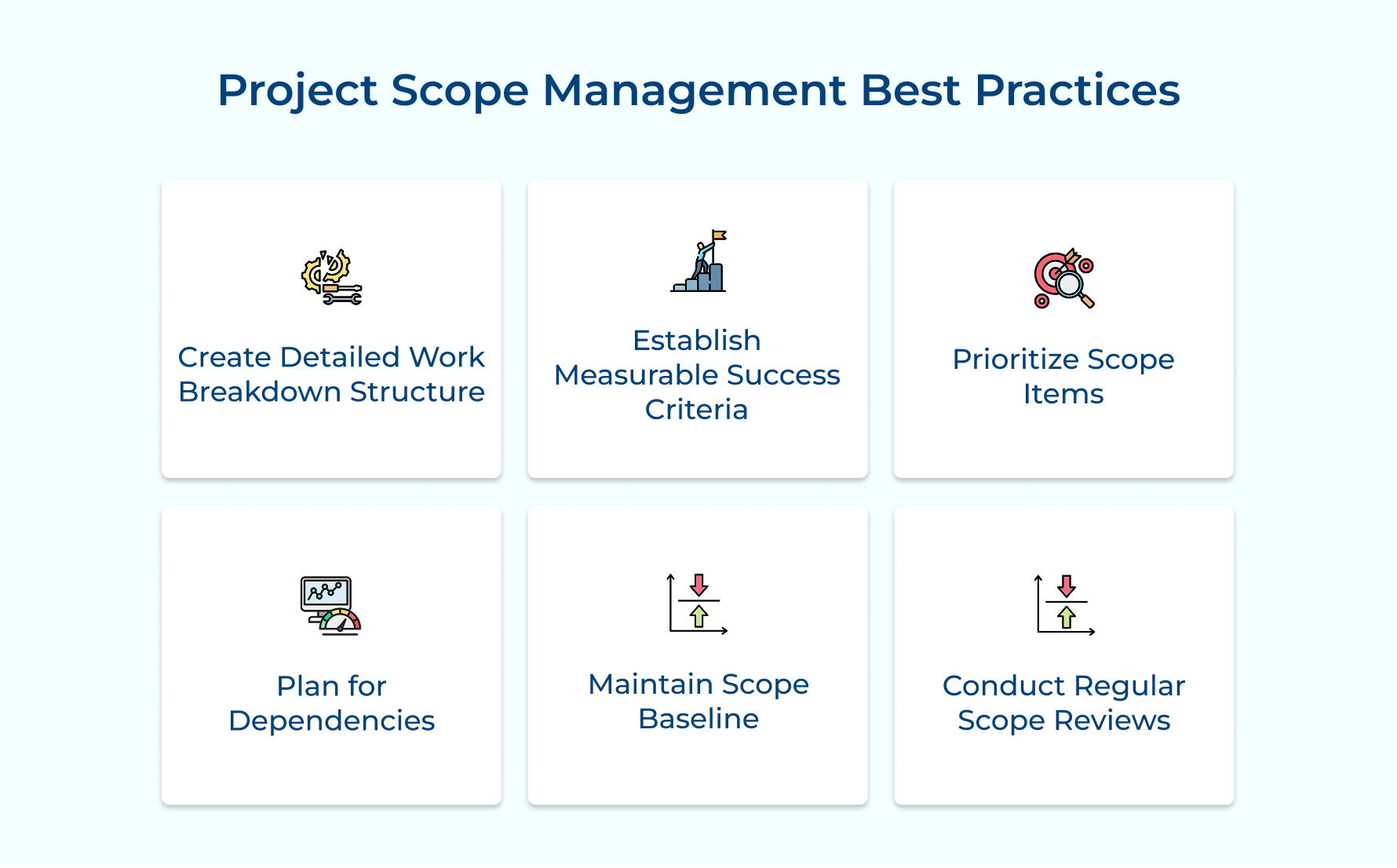What is Project Scope and 7 Steps to Help you Define It

Key Highlights:
- Clear project scope streamlines execution, preventing unauthorized changes while ensuring alignment with client expectations.
- Defined scope helps agencies estimate costs accurately and maintain profit margins with minimal risk.
- A well-outlined scope keeps projects focused, reducing unapproved changes as well as ensuring adherence to agreed parameters.
One of the trickiest parts of project management is staying on track while hitting your goals. Ever had a project go off the rails because the scope wasn’t clear?
Changing client needs along with vague requirements can lead to delays, overspending, and frustrated stakeholders. And let’s face it, scope creep is a real resource-drainer.
When you define and manage your project scope from the start, everything clicks. Your team stays focused, projects run smoothly, and delivery happens on time while being within budget.
Let’s walk through how to nail project scope management and also deal with some of the complex projects.
What is a Project Scope?
Project scope definition is the detailed outline of a project’s objectives, deliverables, timelines, resources and expectations. It sets clear boundaries while defining what is included and excluded in the project.
For agencies offering services like marketing, design, or consulting, the project scope ensures that both the client and the service provider are aligned on goals. Hence, preventing misunderstandings or even scope creep.
A comprehensive scope enables accurate project estimation, efficient resource planning, and effective risk management. It also serves as a reference point for change requests, helping agencies maintain profitability while delivering value to clients.
Key objectives :
- Define clear boundaries as well as limitations of what will and won’t be delivered within the project charter.
- Establish measurable deliverables and success criteria that align with project stakeholders’ expectations as well as business objectives.
- Identify required resources, timeline commitments, and budget constraints to ensure project feasibility.
- Create a baseline for managing change requests and maintaining project control throughout the engagement.
Benefits of Project Scope in Project Management
A clear product scope streamlines project execution, prevents surprises, and ensures alignment with client expectations. Here are the key benefits of the project scope process.
Enhanced Project Control
A clear project scope serves as a roadmap for managing deliverables, timelines, and resources. It helps project managers oversee multiple client projects while avoiding unauthorized changes that could impact profitability.
Improved Cost Management
A well-defined scope allows agencies to estimate costs accurately, set competitive pricing, and maintain profit margins. It also helps identify out-of-scope work and justify additional charges to clients.
Portfolio Management
Clear project scopes enable better management of multiple client projects. They facilitate task prioritization, resource sharing, and timeline coordination across the agency’s portfolio.
Prevents Scope Creep
Outlining project boundaries reduces the risk of unapproved changes. This keeps projects focused and within the agreed-upon parameters, ensuring smooth execution.
Facilitates Risk Management
Identifying potential risks in the scope phase allows agencies to prepare mitigation strategies. Addressing these challenges upfront minimizes disruptions and keeps the project on track.
Performance Measurement
Defined scope provides measurable deliverables and metrics for tracking progress as well as evaluating success. It helps agencies demonstrate value to clients and pinpoint areas for future improvement.
7 Steps to Help You Define Project Scope
Defining project scope is essential for setting clear expectations and ensuring project success. Follow these seven steps to outline boundaries, objectives, and deliverables effectively.
1. Understand Project Objectives and Goals
Defining clear objectives is the first step toward project success. It gives your team a shared purpose and ensures all efforts are aligned with meaningful outcomes. Here’s how you can do it:
1. Identify Fundamental Goals
- Outline the project’s purpose, expected outcomes, and success metrics.
- Ensure the objectives align strategically with your organization’s broader goals.
2. Why Clear Objectives Matter
- They provide direction and purpose, keeping the team focused on what truly matters.
- Clear objectives help stakeholders understand the project’s value and ensure the outputs meet business needs.
3. Create a Structured Objective Document
- List primary and secondary objectives, including measurable success criteria.
- Use this document as a foundation for scope decisions and to validate project activities.
Tips for Defining Objectives
- Conduct workshops to define SMART objectives (Specific, Measurable, Achievable, Relevant, Time-bound).
- Create a hierarchy showing how project goals connect to broader business objectives.
- Develop success metrics for each objective and set regular checkpoints to track progress.
2. Gather Project Requirements and Constraints
Collecting and analyzing project requirements is crucial to shaping a realistic as well as actionable project scope. How can you ensure the process is thorough?
1. Understand the Full Scope of Requirements
- Gather all technical, business, regulatory, and resource-related requirements.
- Identify limitations and constraints that could impact project delivery.
2. Why Requirements Gathering Is Important
- It ensures the project addresses actual needs while considering real-world limitations.
- Helps prevent scope creep and resolves potential conflicts before they disrupt progress.
3. Create Comprehensive Documentation
- Categorize requirements by type, priority, and impact.
- Use this document to guide scope decisions and confirm the feasibility of proposed solutions.
Pro Tips for Effective Requirement Gathering
- Combine methods like interviews, workshops, and surveys to capture inputs from all stakeholder groups to understand if there are any project constraints.
- Link each requirement to business objectives and deliverables for better alignment.
- Maintain a structured log to document constraints, assess their impact, and outline mitigation strategies.
3. Define Main Deliverables
Defining deliverables is all about clarifying what your project will produce, whether it’s a product, service, result, or capability.
1. Identify Tangible and Intangible Outputs
- Document all deliverables your project needs to produce, both tangible (products or services) and intangible (capabilities or results).
- Make sure everything is clearly outlined to avoid confusion later.
2. Clear Deliverables Are crucial because,
- They set concrete targets for your team, ensuring everyone knows what to deliver.
- Clear definitions help manage client expectations, so they know exactly what to expect.
3. Create Detailed Deliverable Specifications
- Include acceptance criteria and quality standards for each deliverable.
- Use these as a foundation for planning, resource allocation, and tracking progress.
Actionable Tips
- Divide each deliverable into smaller components and define acceptance criteria for each.
- Develop mockups or prototypes to create a shared understanding of what’s being delivered.
- Create a dependency map to show relationships between deliverables and ensure smooth coordination.
4. Identify and Allocate Resources
The process of identifying and assigning resources is crucial for ensuring a project can actually deliver on its scope. If it’s human resources, technical tools, or financial assets, you need to identify exactly what’s required to complete each deliverable.
For example, if your project involves developing a new software tool, you’ll need developers, designers, testing tools, and a specific budget for software licenses. Proper resource identification ensures you have everything in place, so the project stays on track and is achievable within the given constraints.
Identifying resources early on prevents potential conflicts—like double-booking team members or running out of essential materials. This helps you plan realistically, based on what’s actually available.
A detailed resource plan is key. It consists of allocating resources across the project timeline to ensure nothing falls through the cracks. By doing so, you can quickly spot gaps in resources or any conflicts that might arise.
5. Draft Your Project Scope Statement
A comprehensive document that formally defines project boundaries, deliverables, assumptions, and constraints. It serves as the official agreement between the project team and stakeholders.
The scope statement provides a clear reference point for all project decisions. It helps prevent misunderstandings and provides a baseline for managing changes throughout the project life cycle.
Reference the scope statement for all project decisions and change requests. Use it to create detailed project plans as well as validate that activities align with the agreed scope.
Use clear, unambiguous language and include visual aids to enhance understanding of complex scope elements. Include explicit sections for inclusions, exclusions, assumptions, and constraints to prevent misinterpretation.
6. Get Buy-in From Stakeholders
Validating your project scope with all stakeholders is essential to ensure everyone is on the same page before you dive into work.
1. Ensure Stakeholder Buy-In
- Review the scope documentation with all relevant stakeholders to ensure understanding and agreement.
- Getting buy-in from stakeholders reduces the risk of disputes later on and maintains their support throughout the project.
2. Conduct Structured Review Sessions
- Hold dedicated review sessions with stakeholder groups to discuss the scope.
- Document feedback carefully and make necessary updates to the scope based on this input.
- Obtain formal sign-off from key stakeholders to confirm agreement.
Pro Tips for Effective Validation:
- Create stakeholder-specific presentations that highlight the parts of the scope most relevant to each group.
- Develop a structured review process with clear checkpoints and sign-off requirements for each group.
- Keep a log of all stakeholder feedback, decisions, and the resulting adjustments to the scope.
7. Establish a Change Control Process
Having a formal change control system is key to maintaining project scope integrity while still being flexible enough to handle necessary adjustments.
How to manage scope changes effectively?
1. Implement a Change Control Process
- Establish a formal system for requesting, evaluating, and approving changes to the project scope throughout the lifecycle.
- It ensures any changes are properly evaluated for impact and approved before implementation.
2. Use Standardized Forms and Procedures
- Implement standardized change request forms and evaluation procedures to streamline the process.
- These forms will help assess the impact of proposed changes on the overall project and document how the scope evolves.
Pro Tips for Effective Change Control:
- Use templates for change requests and impact assessments to ensure a consistent approach to evaluating all changes.
- Define authority levels for change approval based on the magnitude and type of the change, so everyone knows who has the final say.
- Keep a change log that documents all requests, decisions, and resulting adjustments to the scope. This helps build a history of the project’s evolution.
Best Practices for Effective Project Scope Management
Effective project scope management is key to delivering successful projects on time and within budget. These best practices will help you define, control, and maintain your project’s scope throughout its lifecycle.
Create Detailed Work Breakdown Structure
Develop a comprehensive WBS that breaks down deliverables into manageable components. Ensure each element is clearly defined, measurable, and assignable. It helps in accurate resource planning and progress tracking throughout the project.
Establish Measurable Success Criteria
Define specific, quantifiable criteria for measuring project success and deliverable acceptance. Include quality standards, performance metrics, and testing requirements. These criteria should be agreed upon by all stakeholders during scope definition.
Prioritize Scope Items
Not all features or requirements are equally important. Prioritize key deliverables based on stakeholder needs and project goals to focus resources where they matter most, ensuring maximum value is achieved.
Plan for Dependencies
Identify as well as document all internal and external dependencies that could impact the project scope. Include relationships between deliverables, resource dependencies, and external factors.
Maintain Scope Baseline
Create a clear scope baseline that serves as a reference point for measuring changes and progress. Regularly review actual work against this baseline to address any deviations promptly.
Conduct Regular Scope Reviews
Schedule periodic scope reviews to ensure ongoing alignment with project objectives and stakeholder expectations. Use these reviews to identify potential issues early and make necessary adjustments before they become significant problems.
Use Detailed Documentation
Maintain thorough, clear, and accessible scope documentation that includes specific deliverables, timelines, as well as acceptance criteria. Keep language precise and unambiguous, with visual aids where helpful. Ensure all project team members and stakeholders can easily reference as well as understand scope parameters.
Unlocking the Full Potential of Your Project Scope
A well-defined scope ensures projects remain focused on their goals and prevents unnecessary disruptions or deviations.
Effective scope management plays a vital role in navigating evolving client demands and market conditions. Establishing strong scope definition processes and maintaining rigorous control procedures helps agencies improve project success rates while protecting profit margins.
Mastering scope management serves as a key differentiator in the fast-paced agency environment. It strengthens client relationships, ensures predictable outcomes, and provides a competitive edge. Agencies that invest in robust scope management practices are better equipped to consistently deliver successful projects and secure long-term success.
Limit time — not creativity
Everything you need for customer support, marketing & sales.
Neeti Singh is a passionate content writer at Kooper, where he transforms complex concepts into clear, engaging and actionable content. With a keen eye for detail and a love for technology, Tushar Joshi crafts blog posts, guides and articles that help readers navigate the fast-evolving world of software solutions.


